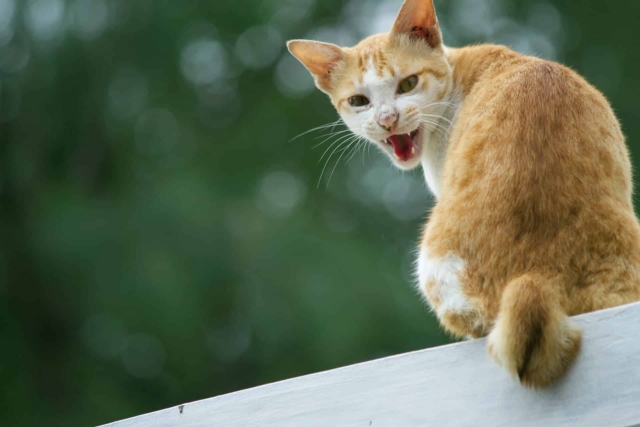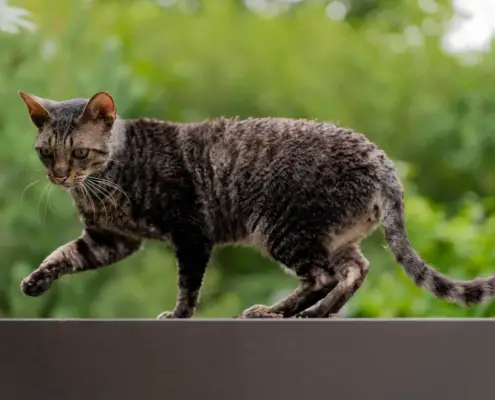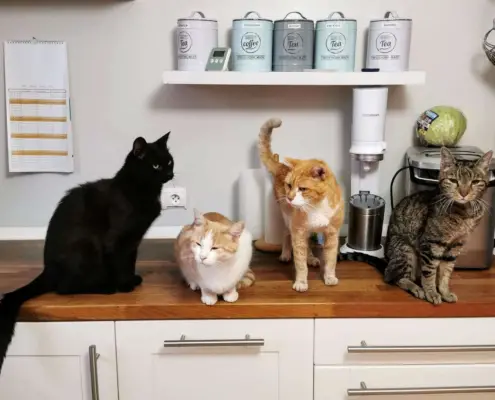
Cat hissing is a vocalization and body language display that cats use to communicate their discomfort, fear, or aggression. It is a warning sign that they are feeling threatened or that their boundaries are being violated. Hissing is a unique sound produced by expelling air forcefully through the mouth while the cat’s body is in a defensive posture. It is often accompanied by other visual cues such as flattened ears, arched back, puffed tail, and dilated pupils.
Why do cats hiss?
Cats hiss as a means of self-defense and to establish personal boundaries. When they feel threatened or scared, hissing is their way of saying, “Back off!” It serves as both a warning to potential threats and as a means to intimidate the perceived aggressor. Cats may also hiss to protect their territory or resources, especially if they feel their space is being invaded. It’s important to note that cats do not hiss without reason; it is a natural and instinctive behavior that helps them navigate their environment and communicate their needs.
Understanding the body language of a hissing cat
To truly comprehend cat hissing, one must also understand the accompanying body language. When a cat hisses, it is often accompanied by a defensive posture. The cat may arch its back, raise its fur, flatten its ears against its head, and position its body in a way that appears larger and more intimidating. Additionally, the cat’s tail may puff up and its pupils may dilate. These physical cues indicate that the cat feels threatened and is ready to defend itself if necessary. It’s crucial to recognize and respect these body language signals to avoid escalating the situation and potentially getting scratched or bitten.
Common situations that trigger cat hissing
Cats hiss in response to various situations that they perceive as threatening or uncomfortable. One common trigger is unfamiliar people or animals invading their space. Cats are territorial creatures and may feel the need to protect their home from intruders. Other triggers include loud noises, sudden movements, being cornered or trapped, and physical discomfort. Cats may also hiss if they feel their personal boundaries are being violated, such as when they are being touched or handled in a way that they find unpleasant or painful. Each cat is unique, and what triggers one cat’s hissing behavior may not affect another cat in the same way.
How to handle a hissing cat
Handling a hissing cat requires patience, understanding, and respect for their boundaries. The first step is to give the cat space and avoid any sudden movements or loud noises that may further agitate them. It’s essential not to force physical contact or attempt to pick up the hissing cat, as this can escalate the situation and potentially result in scratches or bites. Instead, allow the cat to calm down on their own terms. If necessary, create a safe and quiet space for the cat to retreat to, providing them with hiding spots, comfortable bedding, and access to food and water. Slowly introduce positive experiences and interactions over time to help the cat build trust and feel more secure.
Tips for preventing cat hissing
Preventing cat hissing starts with understanding and respecting their needs and boundaries. Here are some tips to help prevent hissing behavior:
- Provide a safe and enriched environment: Ensure your cat has access to hiding places, scratching posts, toys, and vertical spaces to help them feel secure and entertained.
- Socialize your cat: Early and positive socialization with humans, other pets, and different environments can help reduce fear and aggression in cats.
- Avoid punishment: Punishment can increase a cat’s anxiety and exacerbate hissing behavior. Instead, focus on positive reinforcement and reward-based training.
- Maintain a routine: Cats thrive on routine, so establish consistent feeding, play, and sleep schedules to provide them with a sense of security and predictability.
- Respect personal space: Allow your cat to approach you for interactions rather than forcing physical contact. Respect their personal boundaries and give them space when needed.
Myths and misconceptions about cat hissing
There are several myths and misconceptions surrounding cat hissing that can hinder our understanding of this behavior. One common myth is that all hissing cats are aggressive and should be avoided. While hissing can be a sign of aggression, it is often a defensive response to fear or discomfort. It’s important to assess the situation and understand the context in which the hissing occurs. Another misconception is that hissing is a permanent behavior that cannot be changed. In reality, with patience, positive reinforcement, and understanding, hissing behavior can be modified and reduced over time.
The importance of socializing kittens to prevent hissing behavior
Socializing kittens from a young age is crucial in preventing hissing behavior and fostering positive interactions with humans and other animals. Kittens have a critical socialization period between two and seven weeks old, during which they need exposure to various stimuli, experiences, and positive interactions. This period shapes their future behavior and ability to handle unfamiliar situations. By gradually introducing kittens to different people, animals, and environments, we can help them develop confidence, reduce fear, and prevent hissing behavior later in life.
When to seek professional help for a hissing cat
While some hissing behavior is normal, there are instances when seeking professional help is necessary. If a cat’s hissing behavior becomes excessive, persistent, or is accompanied by aggressive actions such as scratching or biting, it may indicate an underlying behavioral or medical issue. Consulting a veterinarian or a certified animal behaviorist can help identify the root cause of the hissing and develop an appropriate behavior modification plan. These professionals can provide guidance, support, and specialized techniques to address the underlying issues and improve the cat’s overall well-being.
Embracing and understanding cat hissing
Cat hissing is a fascinating aspect of feline communication. It serves as a warning sign, allowing cats to communicate their discomfort, fear, or aggression. By understanding the reasons behind cat hissing, recognizing the accompanying body language, and respecting their boundaries, we can navigate our interactions with cats more effectively. Through socialization, positive reinforcement, and providing a safe and enriched environment, we can minimize hissing behavior and create a harmonious relationship with our feline companions. Remember, each cat is unique, and it’s essential to approach them with patience, empathy, and understanding to foster trust and a sense of security.
If you enjoyed my article, I would appreciate you sharing it with your network.

Sima Ndlebe
Sima writes for CatBuzz. He is interested in Cats, Health and Fitness, and Entrepreneurship.
Published: 17 November 2023



